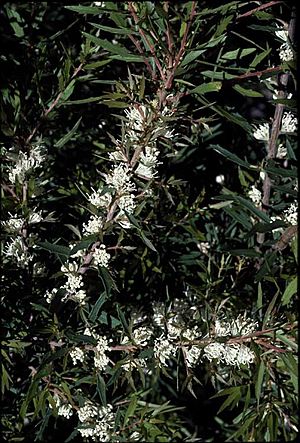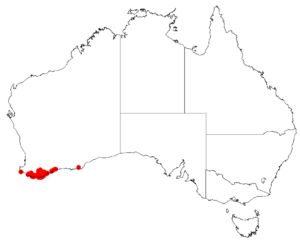Hakea florida facts for kids
Quick facts for kids Hakea florida |
|
|---|---|
 |
|
| Hakea florida in the ANBG | |
| Scientific classification | |
| Genus: |
Hakea
|
| Species: |
florida
|
 |
|
| Occurrence data from AVH | |
Hakea florida is a type of shrub that belongs to the plant family called Proteaceae. It is a special plant because it only grows in a certain area of Western Australia. You can find it along the south coast in the South West, Great Southern, and Goldfields-Esperance regions.
Contents
What is Hakea florida?
This plant is a tall, spiky, bushy shrub. It usually grows about 0.9 to 2.5 meters (3 to 8 feet) tall. It has smooth, soft, grey bark.
Lots of strongly scented white or cream flowers bloom from October to January. They grow where the leaves meet the stem. Its leaves are sharp, pointed, and spread out. They are thick and shaped like a narrow spear, with a main vein down the middle.
The fruit look like warts and are big and round. They are about 2-3 cm (0.8-1.2 inches) long and 2.5 cm (1 inch) wide, with two clear horns. This plant looks very pretty when it's covered in flowers!
How Hakea florida Got Its Name
A botanist named Robert Brown first officially described Hakea florida in 1810. He wrote about it in a scientific paper.
Its name, florida, comes from a Latin word meaning 'many-flowered'. This is because the plant has so many beautiful blooms.
Where Hakea florida Lives
You can find Hakea florida along the south coast of Western Australia. It grows from Manjimup to Denmark and east to the Fitzgerald River National Park.
This plant can grow in many different types of soil. It likes sand, loam, clayey sand, gravel, laterite, and granite. It can grow in sunny spots or in partial shade. It can also handle both frost and dry weather.
Conservation Status
The government of Western Australia says that Hakea florida is "not threatened." This means it is not currently in danger of disappearing.

